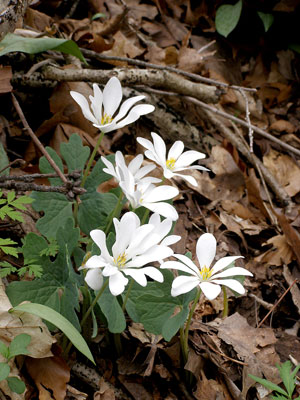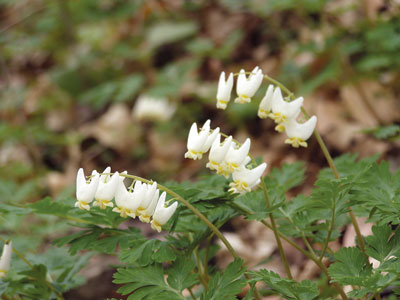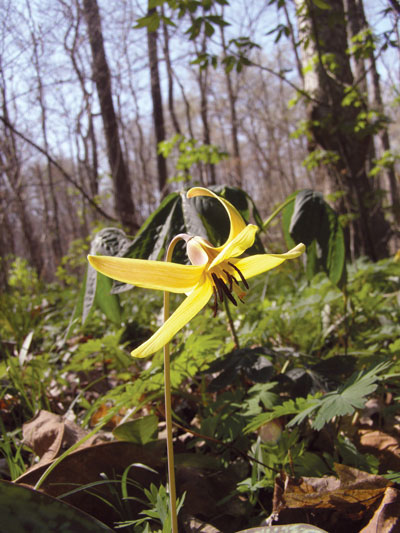Don’t miss them this year
By Ken Moore
Flora Columnist
There’s still time to catch most of the spring ephemerals, but you’d better get outdoors this week or next, or they’ll be gone again for another year.
A favorite spring ephemeral is bloodroot, Sanguinaria canadensis. While the rounded, oddly lobed leaf of bloodroot may stick around for several months before it yellows and disappears, the flower petals, which close in the evenings, will last only a day or two. If you dare touch those fragile petals, they most likely will fall to the ground.
Bloodroots are not nearly as common as trout lilies, which come to mind when one thinks about spring. Spring ephemerals tolerate early spring’s cool temperatures to take advantage of the sun’s rays before the forest canopy darkens the ground. Sometimes the plants will linger on into the early summer, but the flowers last just long enough for pollination and – if pollination is successful – to develop fruit and disperse seed before quietly fading from the woodland scene.
A thrill for wildflower ‘nuts’ is to catch a patch of Dutchman’s breeches, Dicentra cucullaria, during their brief flowering period. Upon close inspection, the white flowers resemble pantaloons on a miniature clothesline, making the common name easy to remember.
Last Sunday, I joined friend Pete Schubert, geologist and another wildflower ‘nut,’ to catch this year’s Dutchman’s breeches flowering in some of the few local sites. The plants are very rare in our area.
Pete’s description explains the rarity: “One of the showiest expanses of local Dutchman’s breeches is along the Flat River north of Durham. As with populations along nearby Eno River at Penny’s Bend and Willie Duke’s Bluff, the Flat River is underlain by resistant diabase, unusual erosion-resistant bedrock that controls the flow of the rivers and contributes a unique chemistry to the overlying soils.
Calcium and magnesium-rich minerals in diabase weather to provide these nutrients in abundance in the soils – unique in the Piedmont. The uncommon plants found here are calciphiles – calcium-loving – typically found in the sweeter soils of the Midwest.â€
Rare Isopyrum biternatum, false rue anemone, with delicate little white flowers that are similar to rue anemone, or windflower, Thalictrum thalictroides, occurs with Dutchman’s breeches on the Flat River. Numerous uncommon puttyroot orchids, Aplectrum hyemale, have appeared with hundreds of bloodroot just above the Dutchman’s breeches on the Eno.
Though these ephemeral beauties are visible for only a couple of weeks at any one location, you can extend your enjoyment at seeing them by walking different trails every week.
There were still a few trout lilies in flower on the cooler north slopes on Sunday but there’ll be no sign of them in a couple of weeks.
For a last chance opportunity to see these beauties this season, check out Duke Garden’s Sunday morning Penny’s Bend trip (call 668-5309) or conduct an Internet search for “Wildflower hikes on the Eno†for a Sunday afternoon Willie Duke’s Bluff trip.
You can follow wildflowers throughout this spring with wildflower classes beginning soon at Duke Gardens and the N.C. Botanical Garden.
Don’t linger; springtime is moving on.
Email Ken Moore at flora@carrborocitizen.com.
Read more Ken Moore Citizen columns at The Annotated Flora.





Comments are closed.